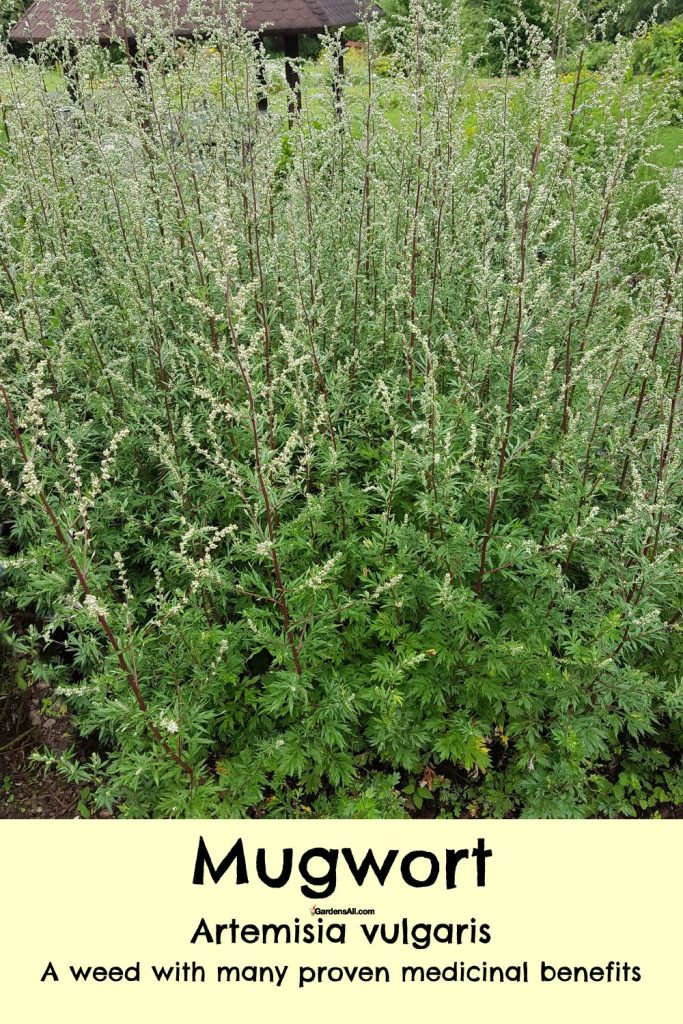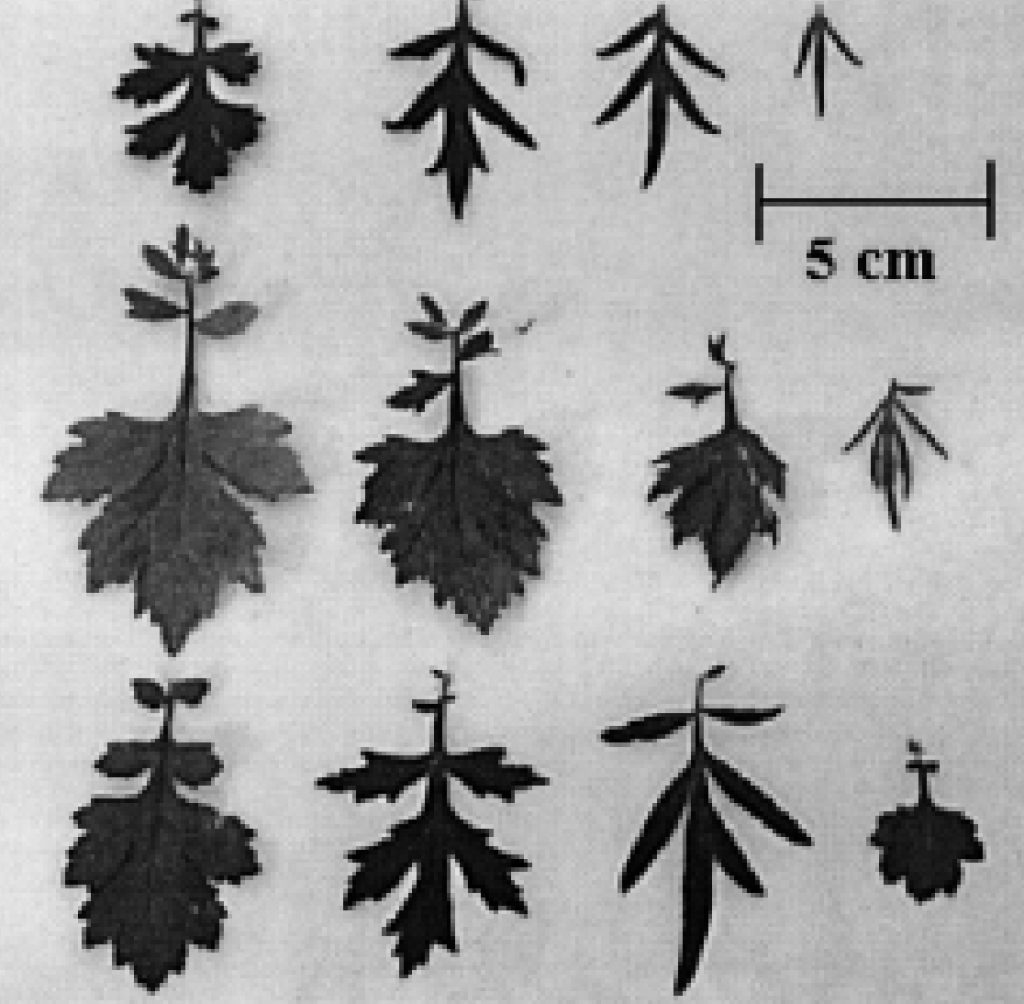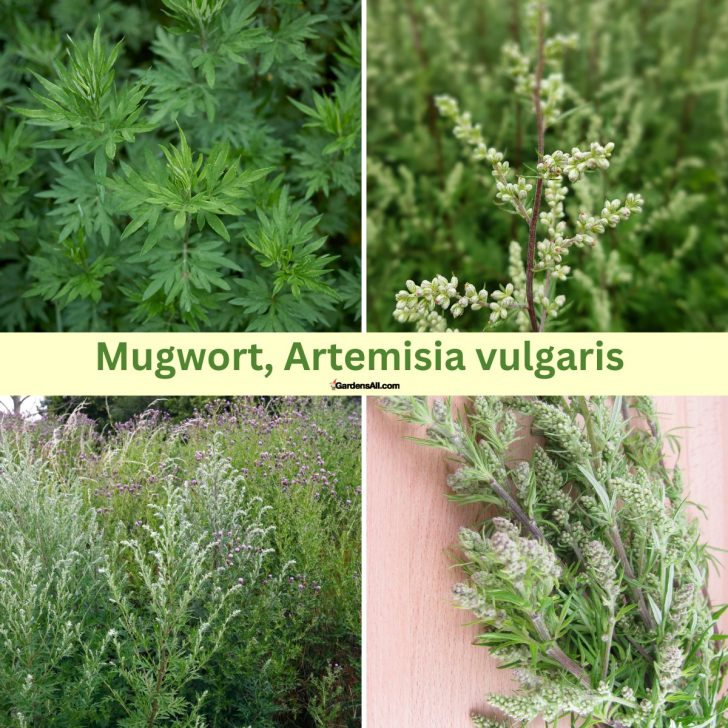Mugwort (Artemisia vulgaris) has a long history of use as a healing herb supported by tradition and science. We enjoy mugwort tea, but we wanted to learn more about mugwort benefits and uses of this humble weed, so we dug into the research, including the proven medicinal uses of mugwort.
Artemisia vulgaris, contains several active compounds such as flavonoids, coumarins, and sesquiterpene lactones that contribute to mugwort medicinal qualities.
In fact, in recent years, researchers have proved that the Artemisia species exhibits many healing benefits. Examples of medicinal benefits of mugwort include antioxidant, hypolipidemic (cholesterol), hepatoprotective (liver), antispasmolytic (muscle spasm), analgesic, estrogenic, cytotoxic (cells toxicity/cancer), antibacterial, antifungal, hypotensive (low blood pressure), and broncholytic (lung supportive) effects. So we break these down a bit more for you in the list below.
In 2015, the Nobel Prize in Medicine was awarded for the discovery of artemisinin, a compound of plant origin found in Artemisia annua (annual mugwort). This has inspired many other studies on the Artemisia genus.
REFERENCE: Study on Significance of Artemisia Vulgaris[1]https://www.ncbi.nlm.nih.gov/pmc/articles/PMC7583039/
Scientifically Proven Medicinal Uses of Mugwort
Most of these health concerns in the following list have more than one study that could be cited. So while we’ve included an extensive list of medicinal uses of mugwort and heaps of corresponding studies in the footnotes, there are more available for the avid armchair researcher.
But before we get to the mugwort medicinal benefits, an important precaution.
Mugwort Allergies
CAUTION: Mugwort is in the Asteraceae (daisy) family, which is the same family as ragweed. So if you have an allergy to ragweed, you may also be affected by mugwort, so proceed with appropriate caution and care.
Now let’s get acquainted with some of the medicinal benefits of mugwort.
Mugwort Benefits
- Analgesic: Mugwort varieties have been used for their analgesic properties to treat colds, fevers, and respiratory problems such as bronchitis and asthma.[2]https://hero.epa.gov/hero/index.cfm/reference/details/reference_id/5950636
- Antibacterial: Proven deleterious against certain strains of bacteria.[3]https://pubag.nal.usda.gov/catalog/7776947[4]https://www.ncbi.nlm.nih.gov/pmc/articles/PMC7583039/
- Anti-cancerous: Studies on the effect of A. vulgaris on cancer cells indicate promising cytotoxic benefits.[5]https://pubmed.ncbi.nlm.nih.gov/25002129/[6]https://cms.turkjps.org/Uploads/Article_12453/247-252.pdf
- Antifungal: Proven antifungal benefits, including for candida albicans.[7]https://pubag.nal.usda.gov/catalog/7849163[8]https://www.ncbi.nlm.nih.gov/pmc/articles/PMC7583039/
- Anti-inflammatory: Mugwort has anti-inflammatory properties that make it useful for treating joint pain and inflammation. The leaves and flowers of mugwort are used to make a poultice or salve that can be applied directly to the affected area.[9]https://pubmed.ncbi.nlm.nih.gov/26236098/[10]https://www.ncbi.nlm.nih.gov/pmc/articles/PMC8245213/
- Antimalarial: One Srilankan study found A. vulgaris effective in remediating mice infected with malaria, and without any harmful toxic effects.[11]http://scholar.googleusercontent.com/scholar?q=cache:hwVIvZTkhdgJ:scholar.google.com/&hl=en&as_sdt=0,34
- Antimicrobial: Other studies also documented the antimicrobial activity of the whole plant and leaf extracts as well as the essential oil of A. vulgaris.
- Antioxidant: Numerous studies indicate compounds in mugwort to be a beneficial antioxidant[12]https://pubmed.ncbi.nlm.nih.gov/18930849/[13]https://www.ncbi.nlm.nih.gov/pmc/articles/PMC7583039/
- Anxiety: Mugwort has a calming effect on the nervous system. The plant’s compounds have a sedative effect that can help to induce sleep and reduce anxiety.[14]https://www.ncbi.nlm.nih.gov/pmc/articles/PMC7583039/
- Asthma: Artemisia reduce bronchial asthma.[15]https://pubmed.ncbi.nlm.nih.gov/19751814/[16]https://www.ncbi.nlm.nih.gov/pmc/articles/PMC9682083/
- Cholesterol: Mugwort demonstrated hypolipidemic (cholesterol reducing) benefit in rats that were fed a high fat diet.[17]https://pubmed.ncbi.nlm.nih.gov/26236098/
- Digestive aid: Mugwort has been used traditionally to treat digestive issues such as bloating, constipation, and diarrhea. The plant’s bitter compounds stimulate the digestive system and improve digestion. The leaves and flowers of mugwort are used to make tea, which is taken before or after meals to improve digestion.[18]https://www.ncbi.nlm.nih.gov/pmc/articles/PMC7583039/[19]https://pubmed.ncbi.nlm.nih.gov/19751814/
- Insecticide: Studies in India and Brazil produced positive results using A. vulgaris oil as a repellent against stored product beetles and also mosquitoes (which we mention below as well).[20]https://www.sciencedirect.com/science/article/abs/pii/S0022474X05000548[21]https://www.tandfonline.com/doi/abs/10.1080/03235408.2012.743389
- Insomnia: Mugwort tea is helpful for reducing insomnia.[22]https://www.ncbi.nlm.nih.gov/pmc/articles/PMC8067791/
- Itching: From various issues such as:
- Liver: A.vulgaris has proven hepatoprotective and beneficial for liver disorders.[26]https://www.ncbi.nlm.nih.gov/pmc/articles/PMC4558445/
- Menstrual disorders: Mugwort has been used to regulate menstrual cycles, ease menstrual cramps, and alleviate symptoms of menopause. The plant contains compounds that mimic the hormone progesterone, which is essential for regulating the menstrual cycle, and can also be abortive. Consult your healthcare advisors before using for such purposes. [27]https://www.ncbi.nlm.nih.gov/pmc/articles/PMC9682083/[28]https://www.researchgate.net/publication/231739539_Estrogenic_Flavonoids_from_Artemisia_vulgaris_L
- Mosquitoes: A study in Tiruchirappalli, India, demonstrated that mugwort essential oil extract is effective at eliminating mosquito larvae, even 24 hours after application at only 10 parts per million (PPM). However, for greater effect, 8 hours at 500 PPM produced a 100% larvae mortality rate.[29]https://jjbs.hu.edu.jo/files/v6n1/Paper%20Number%203m.pdf
- Parasites: Numerous studies have revealed mugwort to be beneficial against a variety of parasitic infections.[30]https://www.ncbi.nlm.nih.gov/pmc/articles/PMC7583039/
- Skin: Artemisia extract, oil and hydrolyzed leaves, in tincture, salve and cream are proven beneficial for:[31]https://www.ncbi.nlm.nih.gov/pmc/articles/PMC7583039/
- conditioner – antioxidant, protectant for skin
- humectant – moisturizer in cream, oil and salve
- disorders – mugworts antimicrobial and anti-inflammatory properties can help to alleviate skin irritation and inflammation, as indicated above under “itching”

Altitudes Affect Mugwort Potency
Now here’s an interesting fact from one thorough scientific study on the medicinal properties of A. vulgaris, that never occurred to us, but which are likely applicable to other plants as well. The greater the altitude, the greater the potency of the mugwort medicinal properties.[32]https://www.ncbi.nlm.nih.gov/pmc/articles/PMC8245213/
The concentration of Artemisia vulgaris’ anti-inflammatory compounds increases with altitudes which ultimately result in higher activity as compared to lower altitudes.
REFERENCE: Scientific study on Anti-Inflammatory Activity of Artemisia vulgaris Leaves, Originating from Three Different Altitudes of Nepal[33]https://www.ncbi.nlm.nih.gov/pmc/articles/PMC8245213/
List of Some Traditional Folklore Uses of Mugwort
Most of these traditional uses, as you can see from the list above, have also been studied as effective by modern standards.
- analgesic
- anti-cancer
- anticonvulsant
- antidiabetic
- antidepressant
- anti-inflammatory
- antiparasitic
- antimalarial
- antimicrobial
- antinociceptiv – (a body’s negative reactivity to negative stimuli)
- antioxidant
- antiparasitic
- anti-tumor
- antiulcerogenic
- anxiety / anxiolytic
- colic
- digestive juices stimulant
- gastrointestinal catarrh
- hepato-protective
- hypertensive diseases
- hypolipidemic
- insomnia
- laxative
- poor appetite
- reduces flatulence
- stress reduction
Used Around the World
In European folk medicine, mugwort, (Artemisia vulgaris) has been traditionally used as a digestive aid and more. In the Philippines, this herb is known as ‘herbaka’ and is used against hypertensive diseases.
REFERENCES:
- Encyclopedia of Medicinal Plants
- Herbal Drugs and Phytopharmaceuticals handbook
- Medicinal Plants of the World
- Study on the Significance of Artemisia Vulgaris L. and its centuries old use in traditional medicine.[34]https://www.ncbi.nlm.nih.gov/pmc/articles/PMC7583039/
What Parts of the Plant Are Used for Mugwort Medicinal Benefits?
The parts of the mugwort plant used for medicinal purposes include the leaves, flowers, and roots. Some people include the tender young stems, but they tend to be bitter. Others use the dried vine stems for basket making.
Mugwort leaves and flowers can be used to make tea, while the roots are used to make tinctures, and also in cooking along with the leaves and flowers, especially in Asian countries.[35]https://www.ncbi.nlm.nih.gov/pmc/articles/PMC7583039/
The plant can also be applied topically in the form of poultices, salves, or oils. It is important to note that while mugwort has many medicinal uses, it should be used with caution as it can cause allergic reactions in some individuals.
The leaves, flowers and roots of mugwort are used for medicinal purposes.
Mugwort Nutrients
While the nutrient content per serving hasn’t been well documented, scientists have determined that there are traces of beneficial nutrients, which along with medicinal compounds, make mugwort an herb worth using.
- Vitamin C: Mugwort contains vitamin C, which is an antioxidant that helps to protect cells from damage and supports the immune system.
- Vitamin E: Mugwort contains small amounts of vitamin E, which is another antioxidant that helps to protect cells from damage.
- Iron: Mugwort contains iron, which is essential for the production of hemoglobin, a protein in red blood cells that carries oxygen throughout the body.
- Calcium: Mugwort contains small amounts of calcium, which is important for bone health and muscle function.
- Potassium: Mugwort contains potassium, which is important for regulating blood pressure and supporting heart health.
- Protein: – Mugwort tissue contains nearly 31% protein.[36]https://cdnsciencepub.com/doi/pdf/10.4141/P01-098
While mugwort does not have significant nutritional value, it is valued for its medicinal properties. The herb contains several active compounds such as flavonoids, coumarins, and sesquiterpene lactones that contribute to its medicinal properties.
Mugwort Identification
Artemisia vulgaris, can be difficult to identify because there are several different phases and shapes of leaf growth on the one plant, as depicted in this graphic.

10 Ways to Use Mugwort
Mugwort (Artemisia vulgaris) can be used in various forms to obtain its medicinal benefits. Here are some common ways to put mugwort medicinal benefits to use. If you’re not finding enough mugwort in your area, you can find it in all forms on Amazon.:
- Bath: Adding dried mugwort leaves to a hot bath can help to relax the body and improve sleep quality. It is believed to be particularly beneficial for women experiencing menstrual cramps. You can create a sachet of dried mugwort flowers and leaves and toss it into a hot bat. You can get empty sachet bags, and dried mugwort on Amazon.
- Disinfectant: Due to the volatile compounds that possess antifungal and antibacterial properties.[38]https://www.ncbi.nlm.nih.gov/pmc/articles/PMC6631396/
- Edible:
- additive – an additive to meat, poultry, fish, and salads
- alcohol –
- in the production of vodkas and herbal wines
- before hops, A. vulgaris was used to flavor beer
- baking – sweet and savory cakes (especially in Japan)
- protein – A. vulgaris tissue contains nearly 31% protein which is nutritionally beneficial to humans and livestock[39]https://cdnsciencepub.com/doi/pdf/10.4141/P01-098
- seasoning – Artemisia vulgaris is a valued spice in Asian cuisine because of the aroma and bitter taste of the herb and the sweet and spicy taste of the roots.[40]https://www.ncbi.nlm.nih.gov/pmc/articles/PMC7583039/
- Food Preservation – The volatile compounds from A. vulgaris contain antifungal and anti-bacterial properties and is a potential alternative source of caryophyllene, germacrene D, and humulene used for disinfectants and preservatives against microorganisms.[41]https://www.ncbi.nlm.nih.gov/pmc/articles/PMC6631396/
You may enjoy the principles of food preservation here. - Oil: Mugwort oil is made by infusing mugwort leaves and flowers in a carrier oil, such as olive oil or coconut oil. It can be applied topically to the skin to relieve joint pain or skin irritation.
You can also buy mugwort essential oil on Amazon. - Food:
- additive – an additive to season meat, poultry, fish, and salads
- alcohol –
- in the production of vodkas and herbal wines
- before hops, A. vulgaris was used to flavor beer
- baking – sweet and savory cakes (especially in Japan)
- seasoning – Artemisia vulgaris is a valued spice in Asian cuisine because of the aroma and bitter taste of the herb and the sweet and spicy taste of the roots.[42]https://www.ncbi.nlm.nih.gov/pmc/articles/PMC7583039/
- Smoking: See more in this article on smoking mugwort benefits and hazards.
- Smudging: Burning dried mugwort as incense or smudging herb can be used to purify the air and promote relaxation. It is also believed to enhance dream experiences and spiritual exploration.
And yes, you can even find mugwort smudge sticks and smudge stick holders on Amazon! - Tea: An infusion or tea is made by steeping fresh or dried mugwort leaves and flowers in hot water. To make the tea, add 1-3 cups of hot water (ideally around 120°F) to 1-3 teaspoons of dried mugwort and let it steep for 5-15 minutes. Mugwort tea can be consumed 1-2 times per day, and made to be stronger or milder to your taste.
You can also buy mugwort tea on Amazon. - Tincture: A tincture is a concentrated liquid extract of mugwort. It is made by soaking fresh or dried mugwort leaves in alcohol for several weeks. Mugwort tincture can be added to water and consumed 1-3 times per day.
You can also buy mugwort tincture on Amazon.
RELATED: You may also enjoy these articles on wild violets tea, dandelion tea and the healthy benefits of rosemary.

Finding Mugwort in the Field
Our herbalist friend, Elizabeth Morgan of DandelionSoap.com, ID’s mugwort in the field. Keep in mind this is spring in North Carolina, and the mugwort is small and flat against the ground. As the season moves on, the mugwort will grow taller, at up to four feet.
See also, Elizabeth’s video in our article on Wild Violets Benefits.
Mugwort is Considered Invasive in Canada
Now were not advising to intentionally cultivate mugwort without researching the potential for invasiveness in your region. However, we are advocating that the many mugwort benefits and medicinal uses of mugwort warrant considering it as a lot more than just a nuisance of a weed!
I’m LeAura Alderson, a garden, herb and plant enthusiast with a passion for discovering the many edible and medicinal benefits of the plants all around us, including the weeds! I’m a writer, editor and media publisher for our family of websites.
While I was certified in fitness and life coaching, I am NOT a health practitioner. However, I’m a lifelong health enthusiast, with a keen interest in healthy, organic foods and making home remedies and the content we share is from our own experience and usage as well as that extracted from scientific research so that you can explore further on your own.
Always seek the advice and guidance of your health practitioners first and foremost.
As a family we’re steadily expanding our gardening, experimentation and knowledge around all things gardening, edible landscaping, fresh organic foods and self sustainability with farming in our future. I also own and manage iCreateDaily.com, a site all about transformation through creation, and the power of positivity, optimism and mindset.
References

